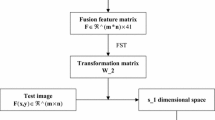Abstract
Improved local tangent space alignment (ILTSA) is a recent nonlinear dimensionality reduction method which can efficiently recover the geometrical structure of sparse or non-uniformly distributed data manifold. In this paper, based on combination of modified maximum margin criterion and ILTSA, a novel feature extraction method named orthogonal discriminant improved local tangent space alignment (ODILTSA) is proposed. ODILTSA can preserve local geometry structure and maximize the margin between different classes simultaneously. Based on ODILTSA, a novel face recognition method which combines augmented complex wavelet features and original image features is developed. Experimental results on Yale, AR and PIE face databases demonstrate the effectiveness of ODILTSA and the feature fusion method.
Similar content being viewed by others
References
Turk M A, Pentland A P. Face recognition using eigenfaces [C]//Proceedings of IEEE Conference on Computer Vision and Pattern Recognition. Maui, Hawaii, USA: IEEE, 1991: 586–591.
Belhumeur P N, Hespanha J P, Kriegman D J. Eigenfaces vs. fisherfaces: Recognition using classspecific linear projection [J]. IEEE Transactions on Pattern Analysis and Machine Intelligence, 1997, 19(7): 711–720.
He X, Cai D, Yan S, et al. Neighborhood preserving embedding [C]//Proceedings of the 10th IEEE International Conference on Computer Vision. Beijing, China: IEEE, 2005: 1208–1213.
He X F, Yan S C, Hu Y X, et al. Face recognition using Laplacian faces [J]. IEEE Transactions on Pattern Analysis and Machine Intelligence, 2005, 27(3): 328–340.
Zhang T, Yang J, Zhao D, et al. Linear local tangent space alignment and application to face recognition [J]. Neurocomputing, 2007, 70: 1547–1553.
Hu H F. Orthogonal neighborhood preserving discriminant analysis for face recognition [J]. Pattern Recognition, 2008, 41(6): 2045–2054.
Li B, Huang D S, Wang C, et al. Feature extraction using constrained maximum variance mapping [J]. Pattern Recognition, 2008, 41(11): 3287–3294.
Li B, Zheng C, Huang D. Locally linear discriminant embedding: An efficient method for face recognition [J]. Pattern Recognition, 2008, 41(12): 3813–3821.
Li H F, Jiang T, Zhang K S. Efficient and robust feature extraction by maximum margin criterion [J]. IEEE Transactions on Neural Networks, 2006, 17(1): 157–165.
Saul L K, Roweis S T. Think globally, fit locally: Unsupervised learning of low dimensional manifolds [J]. Journal of Machine Learning Research, 2003, 4(2): 119–155.
Lei Y K, Xu Y M, Yang J A, et al. Feature extraction using orthogonal discriminant local tangent space alignment [J]. Pattern Analysis & Applications, 2012, 15(3): 249–259.
Zhang P, Qiao H, Zhang B. An improved local tangent space alignment method for manifold learning [J]. Pattern Recognition Letters, 2011, 32(2): 181–189.
Chaudhury K N, Unser M. Construction of Hilbert transform pairs of wavelet bases and Gabor-like transforms [J]. IEEE Transactions on Signal Processing, 2009, 57(9): 3411–3425.
Kingsbury N. The dual-tree complex wavelet transform: A new efficient tool for image restoration and enhancement [C]//Proceedings of the 17th European Signal Processing Conference. Rhodos, Greece: Elsevier, 1998: 319–322.
Yan S, Xu D, Zhang B, et al. Graph embedding and extensions: A general framework for dimensionality reduction [J]. IEEE Transactions on Pattern Analysis and Machine Intelligence, 2007, 29(1): 40–51.
Cai D, He X, Han J. SRDA: An efficient algorithm for large-scale discriminant analysis [J]. IEEE Transactions on Knowledge and Data Engineering, 2008, 20(1): 1–12.
Martinez A, Benavente R. The AR database [R]. Barcelona, Spain: CVC, 1998.
Sim T, Baker S, Bsat M. The CMU pose, illumination, and expression database [J]. IEEE Transactions on Pattern Analysis and Machine Intelligence, 2003, 25(12): 1615–1618.
Author information
Authors and Affiliations
Corresponding author
Additional information
Foundation item: the National Natural Science Foundation of China (No. 61004088), and the Key Basic Research Foundation of Shanghai Municipal Science and Technology Commission (No. 09JC1408000)
Rights and permissions
About this article
Cite this article
Zhang, Q., Cai, Yz. & Xu, Xm. Orthogonal discriminant improved local tangent space alignment based feature fusion for face recognition. J. Shanghai Jiaotong Univ. (Sci.) 18, 425–433 (2013). https://doi.org/10.1007/s12204-013-1417-y
Received:
Published:
Issue Date:
DOI: https://doi.org/10.1007/s12204-013-1417-y
Key words
- manifold learning
- linear extension
- orthogonal discriminant improved local tangent space alignment (ODILTSA)
- augmented Gabor-like complex wavelet transform
- face recognition
- information fusion




